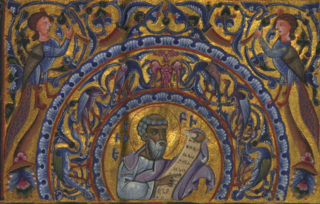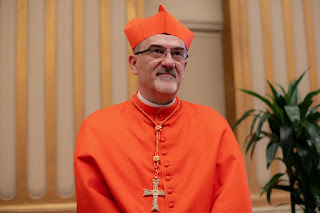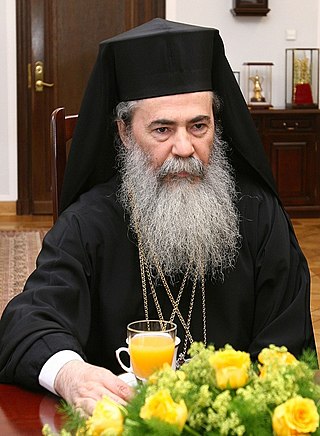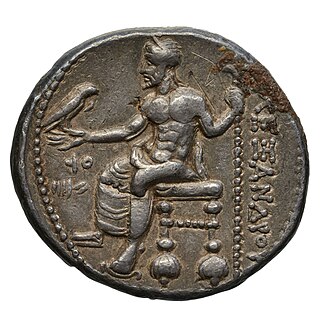Related Research Articles

Eusebius of Caesarea, also known as Eusebius Pamphilus, was a Greek Syro-Palestinian historian of Christianity, exegete, and Christian polemicist. In about AD 314 he became the bishop of Caesarea Maritima in the Roman province of Syria Palaestina. Together with Pamphilus, he was a scholar of the biblical canon and is regarded as one of the most learned Christians during late antiquity. He wrote Demonstrations of the Gospel, Preparations for the Gospel and On Discrepancies between the Gospels, studies of the biblical text. As "Father of Church History", he produced the Ecclesiastical History, On the Life of Pamphilus, the Chronicle and On the Martyrs. He also produced a biographical work on Constantine the Great, the first Christian Roman emperor, who was Augustus between AD 306 and AD 337.

Caesarea, also Caesarea Maritima, Caesarea Palaestinae or Caesarea Stratonis, was an ancient and medieval port city on the coast of the Eastern Mediterranean, and later a small fishing village. It was the capital of Roman Judaea, Syria Palaestina and Palaestina Prima, successively, for a period of c.650 years, and a major intellectual hub of the Mediterranean, from the time of Herod I until the Muslim conquest of the Levant. Today, the site is part of the Caesarea National Park, on the western edge of the Sharon plain in Israel.

Patriarchate is an ecclesiological term in Christianity, designating the office and jurisdiction of an ecclesiastical patriarch. According to Christian tradition three patriarchates were established by the apostles as apostolic sees in the 1st century: Rome, Antioch, and Alexandria. Constantinople was added in the 4th century and Jerusalem in the 5th century. Eventually, together, these five were recognised as the pentarchy by the Council of Chalcedon in 451.

The Patriarch of Alexandria is the archbishop of Alexandria, Egypt. Historically, this office has included the designation "pope".

An exarch was the holder of any of various historical offices, some of them being political or military and others being ecclesiastical.

The Latin Patriarchate of Jerusalem is the Latin Catholic ecclesiastical patriarchate in Jerusalem, officially seated in the Church of the Holy Sepulchre. It was originally established in 1099, with the Kingdom of Jerusalem encompassing the territories in the Holy Land newly conquered by the First Crusade. From 1374 to 1847 it was a titular see, with the patriarchs of Jerusalem being based at the Basilica di San Lorenzo fuori le Mura in Rome. Pope Pius IX re-established a resident Latin patriarch in 1847.

The Greek Orthodox patriarch of Jerusalem or Eastern Orthodox patriarch of Jerusalem, officially patriarch of Jerusalem, is the head bishop of the Greek Orthodox Patriarchate of Jerusalem, ranking fourth of nine patriarchs in the Eastern Orthodox Church. Since 2005, the Eastern Orthodox patriarch of Jerusalem has been Theophilos III. The patriarch is styled "Patriarch of the Holy City of Jerusalem and all Holy Land, Syria, beyond the Jordan River, Cana of Galilee, and Holy Zion." The patriarch is the head of the Brotherhood of the Holy Sepulchre, and the religious leader of about 130,000 Eastern Orthodox Christians in the Holy Land, most of them Palestinian Christians in Israel and Palestine.
The Patriarch of Antioch is a traditional title held by the bishop of Antioch. As the traditional "overseer" of the first gentile Christian community, the position has been of prime importance in Pauline Christianity from its earliest period. This diocese is one of the few for which the names of its bishops from the apostolic beginnings have been preserved. Today five churches use the title of patriarch of Antioch: one Oriental Orthodox ; three Eastern Catholic ; and one Eastern Orthodox.

The Greek Orthodox Patriarchate of Jerusalem, also known as the Greek Orthodox Church of Jerusalem, is an autocephalous church within the wider communion of Eastern Orthodox Christianity. Established in the mid-fifth century as one of the oldest patriarchates in Christendom, it is headquartered in the Church of the Holy Sepulchre in Jerusalem and led by the patriarch of Jerusalem, currently Theophilos III. The patriarchate's ecclesiastical jurisdiction includes roughly 200,000 to 500,000 Orthodox Christians across the Holy Land in Palestine, Jordan and Israel.
Saint Pamphilus, was a presbyter of Caesarea and chief among the biblical scholars of his generation. He was the friend and teacher of Eusebius of Caesarea, who recorded details of his career in a three-book Vita that has been lost.

Pentarchy is a model of Church organization formulated in the laws of Emperor Justinian I of the Roman Empire. In this model, the Christian Church is governed by the heads (patriarchs) of the five major episcopal sees of the Roman Empire: Rome, Constantinople, Alexandria, Antioch, and Jerusalem.
The See of Tyre was one of the most ancient dioceses in Christianity. The existence of a Christian community there in the time of Saint Paul is mentioned in the Acts of the Apostles. Seated at Tyre, which was the capital of the Roman province of Phoenicia Prima, the bishopric was a metropolitan see. Its position was briefly challenged by the see of Berytus in the mid-5th century; but after 480/1 the metropolitan of Tyre established himself as the first (protothronos) of all those subject to the Patriarch of Antioch.

Jerusalem's role in first-century Christianity, during the ministry of Jesus and the Apostolic Age, as recorded in the New Testament, gives it great importance, both culturally and religiously, in Christianity. Jerusalem is generally considered the cradle of Christianity.
Early Christianity, otherwise called the Early Church or Paleo-Christianity, describes the historical era of the Christian religion up to the First Council of Nicaea in 325. Christianity spread from the Levant, across the Roman Empire, and beyond. Originally, this progression was closely connected to already established Jewish centers in the Holy Land and the Jewish diaspora throughout the Eastern Mediterranean. The first followers of Christianity were Jews who had converted to the faith, i.e. Jewish Christians. Early Christianity contains the Apostolic Age and is followed by, and substantially overlaps with, the Patristic era.

The Theological Library of Caesarea Maritima, or simply the Library of Caesarea, was the library of the Christians of Caesarea Maritima in Syria Palaestina in ancient times.

Ptolemais was a ancient port city on the Canaanite coast in the ancient region of Phoenicia, in the location of the present-day city of Acre, Israel. It was also called Ptolemais in Canaan and Ake-Ptolemais. It was an ancient bishopric that became a double Catholic titular see.
The Diocese of Scythopolis is a titular see in Israel/Jordan and was the Metropolitan of the Roman province of Palestina II. It was centered on Modern Beth Shean (Bêsân).
For millennia, the Greeks in Israel have been prominently present in the land. Greek expatriates comprise most of the leadership of the Eastern Greek Orthodox Church in Israel and the Palestinian Territories, in an arrangement that long predates the modern State of Israel.
Catholic dioceses in the Holy Land and Cyprus is a multi-rite, international episcopate in Israel and Cyprus.
This is a list of the bishops of Jerusalem before the Council of Chalcedon (451), which provoked a schism.
References
- ↑ Annuario Pontificio 2013 (Libreria Editrice Vaticana 2013 ISBN 978-88-209-9070-1), "Sedi titolari", p. 867
- ↑ Eusebius of Caesarea, "Ecclesiastical History," VII.xxxii.25.
- ↑ Jerome, "Epistles" xxxiv
- ↑ Swete, H. B. Introduction to the Old Testament in Greek, pp. 74-75.
- ↑ Cross, F. L.. ed. (1957) The Oxford Dictionary of the Christian Church. London: Oxford University Press; p. 214
- ↑ newadvent.org's Apostolic Constitutions Book VII: "Of Cæsarea of Palestine, the first was Zacchæus, who was once a publican; after whom was Cornelius, and the third Theophilus."
- ↑ Encyclopédie Franciscaine Archived 2011-07-28 at the Wayback Machine